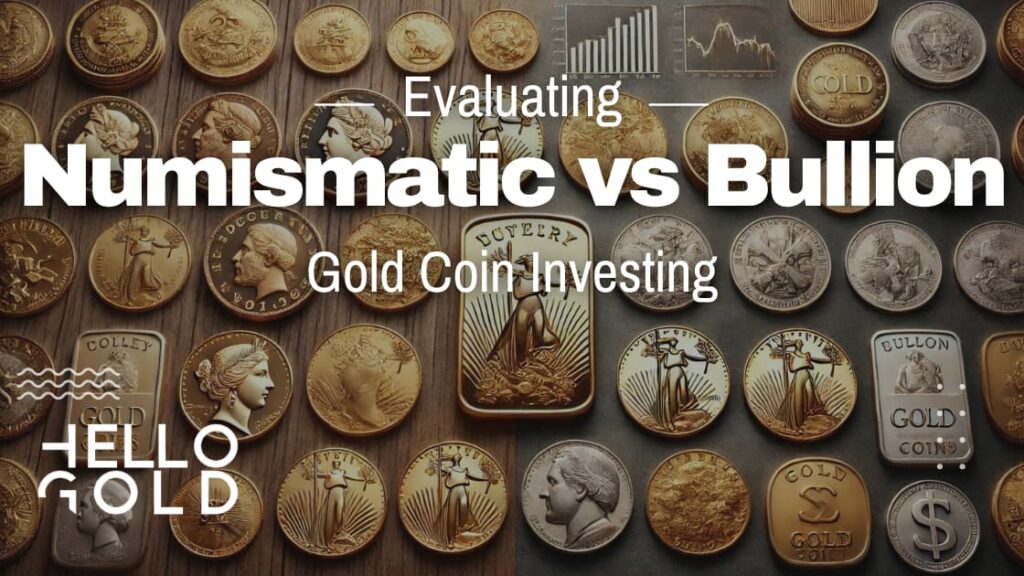Want to make your retirement plan stronger than just stocks and bonds?
A gold IRA could be the right fix. This special account lets you own real precious metals, providing a possible shield against economic uncertainty.
Learn what gold IRAs are, how they work, and why they might be a game-changer for your retirement goals.
Understanding Gold IRAs
Retirement isn’t just about relaxation and leisure; it’s about financial security. While traditional IRAs and 401(k)s are popular choices, a gold IRA offers a unique twist.
It lets you add a tangible, historically stable asset to your retirement portfolio: gold.
So, if you’re looking for a way to diversify and potentially protect your savings against economic uncertainties, a gold IRA could be worth exploring.
Let’s break down what a gold IRA is, how it works, and why it might be a smart move for your retirement strategy.
What is a Gold IRA?
This unique retirement account, officially known as a precious metals IRA, allows you to diversify your portfolio by holding physical precious metals like gold, silver, platinum, and palladium. Think of it as a special nest egg where, instead of just stocks and bonds, you can include tangible assets that can provide a hedge against inflation and market volatility.
A gold IRA, also known as a precious metals IRA, is designed to offer a stable store of value for your retirement savings. Unlike traditional investments, these accounts let you own physical gold and other approved metals, giving you a sense of security and control over your assets.
How Gold IRAs Work
Gold IRAs operate similarly to traditional IRAs, but with one key difference: instead of holding paper assets like stocks and bonds, they hold physical precious metals. This means you’ll actually own gold, silver, platinum, or palladium coins or bars that are stored securely on your behalf in an IRS-approved depository.
But how do you get started with a gold IRA?
The process involves opening a self-directed IRA, choosing a reputable custodian, funding your account, and selecting your precious metals.
We’ll cover each of these steps in detail later in this guide, so you’ll know exactly what to expect.
The key thing to understand now is that a gold IRA presents a distinctive avenue to incorporate physical precious metals into your retirement savings. It’s a bridge between the traditional world of retirement investing and the tangible world of gold and other precious metals.
Advantages of Gold IRAs
Gold IRAs offer several compelling benefits that can enhance your retirement strategy:
- Diversification: Including physical precious metals in your retirement portfolio helps spread risk. Gold often performs well when traditional investments such as equities and fixed-income securities are struggling, which can provide a stabilizing effect during market downturns.
- Inflation Hedge: Gold has historically maintained its value over time, making it an effective hedge against inflation. As the cost of living rises, gold can help preserve your purchasing power.
- Control: Self-directed IRAs offer greater control and flexibility over your investment choices compared to traditional IRAs. You can decide which metals to purchase and when to buy or sell them, tailoring your strategy to your financial goals.
- Tangible Asset: There’s something inherently satisfying about owning a physical asset. Unlike paper investments, you can actually hold gold in your hands, which can offer a feeling of assurance and stability.
While gold IRAs offer significant advantages, it’s important to note that they also come with potential risks and downsides. These include market volatility, storage fees, and the potential for lower liquidity compared to other investments.
As with any investment, it’s crucial to carefully consider your risk tolerance and long-term financial goals before deciding if a gold IRA is the right choice for you.
Gold IRA Rules and Regulations
Putting money into a gold IRA can be a prudent choice for your retirement planning, but it’s important to know the rules and regulations that control these special retirement accounts. While the guidelines might look complicated at first glance, we’ll break down the key stuff you need to know, making sure you’re ready to make informed choices.
IRA Eligibility
The good news is that gold IRAs can be flexible, working with different types of retirement accounts. You can set up a Traditional, Roth, SEP, or SIMPLE IRA to hold precious metals, each with its own quirks:
Traditional and SEP IRAs
These accounts are open to everyone, no matter your income level.
With Traditional IRAs, you make contributions with pre-tax dollars, scoring an immediate tax break.
SEP IRAs are tailored for self-employed people and small business owners, boasting higher contribution limits based on your income.
Roth IRAs
To put money into a Roth, you’ll need to meet specific income limits.
The upside? Your contributions are made with after-tax dollars, meaning your withdrawals in retirement are completely tax-free – a sweet deal if you qualify.
SIMPLE IRAs
Designed for small businesses and self-employed folks, SIMPLE IRAs use pre-tax contributions, similar to Traditional IRAs.
Choosing the right type depends on your current money situation and future tax expectations, so it’s worth looking at your options.
Contribution Limits
The IRS sets yearly contribution limits for gold IRAs, and these apply across all your retirement accounts. For 2024, the limits are:
- $7,000 if you’re under 50 years old.
- $8,000 if you’re 50 or older, thanks to the catch-up contribution allowance.
Remember, these limits are total across all your IRAs, so plan accordingly to avoid going over the thresholds.
Approved Precious Metals
The IRS is quite picky about the metals you can hold in a gold IRA, and for good reason – they want to make sure you’re investing in quality assets. Approved precious metals must meet strict purity standards:
- Gold: .995+ purity
- Silver: .999+ purity
- Platinum and Palladium: .9995+ purity
Popular choices that meet these standards include American Eagle coins, Canadian Maple Leaf coins, and bars from approved refineries. However, avoid collectibles and numismatic coins – they’re not IRS-approved and can get you in trouble.
Prohibited Transactions
To keep the integrity of your gold IRA, the IRS has strict rules against self-dealing. Here’s what you need to know:
- You can’t take personal possession of the metals in your IRA. They must be stored in a government-sanctioned facility to remain compliant.
- No buying metals from or selling metals to your own IRA. Breaking these rules can lead to severe penalties, including hefty fines and the potential disqualification of your IRA, which could result in significant tax costs.
Following these guidelines is crucial to make sure your gold IRA stays secure and follows IRS regulations.
Distribution Rules
When it comes to taking distributions from your gold IRA, there are a few key rules to remember:
Traditional Gold IRAs
You’ll be subject to Required Minimum Distributions (RMDs) starting at age 72. Not taking these distributions can result in hefty penalties, so it’s essential to stay on top of your RMDs.
Additionally, early withdrawals before age 59- generally bring a 10% penalty and are taxed as ordinary income, though some exceptions apply.
Roth Gold IRAs
These accounts offer more flexibility – no RMDs, and qualified withdrawals are completely tax-free, making them an attractive option for many investors.
Remember, knowing the distribution rules for your specific IRA type is crucial to avoid costly penalties and maximize the benefits of your gold IRA investment.
Setting Up a gold IRA
Investing in a gold IRA could prove a wise move to possibly make your retirement savings more stable and secure. While the process may seem daunting initially, this guide will give you a clear, step-by-step way to set up your gold IRA, making sure you have the knowledge to make informed choices every step of the way.
Choose a Trustworthy Custodian
Your custodian is your partner in managing and protecting your gold IRA, so picking the right one is crucial. Think about these factors:
Reputation and Experience – Go with a custodian with a strong record and lots of experience handling gold IRAs. Think of it as choosing an experienced guide for your investment journey.
Fee Structures – Not all custodians charge the same fees, so it’s important to compare setup fees, yearly maintenance fees, storage fees, and transaction fees across different providers. Knowing these costs ahead of time can help you avoid any unpleasant surprises later on.
Storage Options – A good custodian should offer secure, IRS-approved storage choices. Typically, you can opt between separated storage (your metals are kept individually) and combined storage (your metals are housed with others). Separated storage usually provides more security and peace of mind, but it may cost more.
Buyback Programs – A buyback program lets you sell your precious metals back to the custodian. This can be very helpful if you need to convert your assets to cash quickly. Look for custodians that offer favorable buyback terms and low fees.
Service Levels – Good customer service can make a big difference when managing your gold IRA. Find a custodian that provides responsive and knowledgeable support to help you with any questions or issues that might come up.
Remember, your custodian also acts as the record-keeper for tax purposes, keeping your gold IRA compliant with IRS rules.
Rollover vs. Transfer
Putting money into your gold IRA is a key step in expanding your retirement savings with precious metals.
You have two main choices: rollover and transfer.
Let’s look at each one to decide which method best fits your needs.
Rollover
A rollover means taking a payout from your current retirement account (like a traditional IRA or 401(k)) and reinvesting it into your new gold IRA within 60 days.
Here’s the breakdown:
- Start the Rollover: Contact your current retirement account provider to begin the rollover process.
- Get the Payout: The funds will be paid out to you, either directly or by check. 3. Deposit into gold IRA: Ensure you move the entire rollover amount to your newly-opened gold IRA account within the 60-day window.
Important Points:
- 60-Day Rule: Not completing the rollover within 60 days can lead to taxes and penalties.
- One Rollover per Year: The IRS limits you to one rollover per 12-month period per IRA account.
Transfer
A transfer is a direct movement of funds from one retirement account custodian to another. You never take control of the funds during this process.
Here’s the breakdown:
- Start the Transfer: Contact both your current and new custodian to begin the transfer process.
- Direct Transfer: Your current custodian will transfer the funds directly to your new gold IRA custodian.
Important Points:
- No Tax Implications: Transfers are not taxed, and there are no limits on how many you can do.
- Simpler Process: Transfers are usually considered easier and more secure than rollovers.
Which Choice is Right for You?
Both rollovers and transfers are good options for funding your gold IRA. However, transfers are often preferred because of their simplicity and no tax implications.
If you’re not sure which method is best for you, talk to a financial advisor or tax pro to discuss your specific situation.
Fund Your Account
With your custodian picked and rollover or transfer decision made, it’s time to make your gold IRA real by putting funds into it. Here are the options to get money into your account:
Direct Contributions:
- Fresh Start: If you don’t have an existing retirement account to transfer or roll over from, you can fund your gold IRA with direct contributions.
- Yearly Limits: For 2024, the maximum contribution for those below 50 years old is $7,000, while individuals aged 50 and above can contribute up to $8,000.
- Tax Benefits: These contributions can often be deducted from your taxable income, potentially lowering your tax bill.
- Roth IRA Considerations: If you’re eligible for a Roth IRA, contributions come from money already taxed, but offer tax-free withdrawals in retirement.
Please note that contribution limits and eligibility for Roth IRAs may vary based on your income and tax filing status. Consult knowledgeable professionals for personalized guidance.
Tax-Free Transfers (From Existing IRAs/401(k)s):
- Smooth Transition: This means moving funds directly from an existing IRA or 401(k) into your newly established gold IRA, all without causing taxes or penalties.
- Custodian Coordination: Reach out to your current custodian and the new one to initiate the transfer. They’ll guide you through the needed paperwork and make sure the process goes smoothly.
No matter which method you pick, funding your gold IRA account is a straightforward process that gets you one step closer to diversifying your nest egg with precious metals.
Select Your Precious Metals
Picking the right precious metals for your gold IRA is more than just choosing shiny objects. Here are some things to think about:
Growth Potential: Different precious metals have varying growth potentials. Gold is often seen as a stable, long-term investment, while silver, platinum, and palladium might offer higher growth potential but come with increased volatility.
Risk Tolerance: Look at your risk tolerance to decide the right mix of metals for your portfolio. Gold is typically preferred for its stability, whereas other metals might be better if you’re willing to take on more risk for potentially higher returns.
Liquidity Needs: Consider how liquid the metals you choose are. Gold is generally more liquid than other precious metals, making it easier to buy and sell as needed.
Directing Purchases: Work closely with your custodian to direct specific purchases of approved metals. Only certain types of precious metals are allowed in a gold IRA, including those that meet IRS purity standards such as gold, silver, platinum, and other IRS-approved metals.
Avoid High-Pressure Sales Tactics: Be cautious of salespeople pushing overpriced ‘collector’ coins or other products not suited for IRAs. Stick to approved precious metals to ensure compliance and avoid unnecessary costs.
By carefully thinking about these factors and working closely with your custodian, you can build a diverse and robust gold IRA, optimizing your retirement portfolio for stability and growth.
Storing Your Precious Metals
When you invest in a gold IRA, one key thing to think about is where your precious metals will be kept.
While you might like the idea of keeping those shiny bars and coins at your house, federal regulations are very specific.
To keep your investment safe, all precious metals in a gold IRA must be stored at an IRS-approved facility.
Depository Storage
These storage places are not normal. They have top security to protect your assets. We’re talking state-of-the-art vaults, 24/7 monitoring, and advanced security with alarms, motion sensors, and security cameras.
Your precious metals will be watched all the time, keeping them safe 24/7.
But wait, there’s more – these facilities also have full insurance coverage. This protects your investment against theft, damage, or loss. It’s like your metals are wrapped in a security blanket, giving you extra peace of mind.
Now, this level of security and protection isn’t free. These storage places typically charge fees based on the total value of your account. The fees can vary between providers, so it’s worth comparing to find the best combo of security and cost.
Segregated vs. Commingled Storage
Once you pick a facility, you’ll need to decide between segregated and commingled storage. This choice determines how your precious metals are stored.
Segregated Storage means your metals are separated from other investors’ metals. Each investor’s assets are stored in their own designated area, so the exact bars or coins you bought are not mixed with anyone else’s.
This option has the highest security and control, since you can be sure your metals are right where they should be, untouched by other assets.
The downside? Segregated storage usually costs more due to the individual storage needs.
On the other hand, Commingled Storage means pooling your metals with those of other investors. While your assets are combined in one secure vault, each investor’s holdings are tracked closely to ensure accurate ownership.
Commingled storage often costs less than segregated, but it has a slightly higher risk of potential mix-ups or errors, though rare, because of the tracking involved.
Taking Distributions In-Kind
When you want to access your precious metals in retirement, you have two main choices: selling your metals for cash or taking an in-kind distribution.
Selling is more straightforward – you offload your precious metals through your custodian and get the cash value. This makes it easy to liquidate your assets for retirement costs.
But if you want the actual metals, an in-kind distribution allows this. Here’s how it works:
- Request the Distribution: Contact your custodian to ask for an in-kind distribution. You’ll complete paperwork and specify the metals you want.
- Shipping and Handling: The facility will prepare and securely pack your metals for delivery. Expect to pay extra fees for this.
- Receive the Metals: Once you get them, you’ll have the physical metals. Now it’s key to have a secure place to store them, whether at home or a private vault.
While selling gives you quick cash, consider the potential taxes.
The metals’ value at distribution is taxed as income that year, which could really increase your taxes.
Talking to a tax pro can help know the full impact of an in-kind distribution.
The key is understanding your choices and making informed decisions that match your retirement goals and money situation.
Tax Implications
When it comes to investing in a gold IRA, understanding the tax effects is crucial.
These specialized retirement accounts offer valuable tax benefits, similar to their traditional counterparts, but with a few unique considerations.
Here are the key points to help you make informed decisions.
Tax Benefits
One of the biggest advantages of gold IRAs is their tax-advantaged growth potential. Just like traditional IRAs, you have the choice between tax-deferred and tax-free growth, depending on the type of account you open.
With a Traditional Gold IRA, your contributions are made with pre-tax dollars, which means you can deduct those contributions from your taxable income for the year. This provides an immediate tax break, lowering your upfront tax liability.
The money you contribute can then grow tax-deferred, meaning you won’t pay taxes on the gains until you start taking distributions in retirement. At that point, your withdrawals will be taxed as ordinary income.
The strategy here is that you might be in a lower tax bracket when you retire, potentially reducing the overall tax burden.
On the other hand, a Roth Gold IRA allows you to contribute after-tax dollars, so you don’t get an immediate tax deduction.
However, the real advantage comes during retirement: your withdrawals are completely exempt from taxes, as long as you’ve had the account for at least five years and are at least 59 1/2 years old.
This can be a fantastic option if you expect to be in a higher tax bracket in your later years or if you anticipate significant growth in your investments, as you won’t have to pay taxes on those gains.
Both types of gold IRAs offer valuable tax benefits, but the choice between a Traditional or Roth account ultimately depends on your current tax situation and your expectations for the future. It’s worth taking the time to evaluate your options and consider consulting a financial advisor to ensure you make the most advantageous decision for your unique circumstances.
Early Withdrawal Penalties
While gold IRAs offer excellent tax benefits, it’s crucial to be aware of the potential penalties for early withdrawals. Generally, if you take a distribution from your gold IRA before reaching age 59 1/2, you’ll be subject to a 10% early withdrawal penalty on top of ordinary income tax.
This penalty is the IRS’s way of encouraging you to keep your retirement savings intact until you actually reach retirement age. However, there are a few exceptions where you can avoid the 10% penalty (though you’ll still owe taxes on the withdrawal):
- Disability: If you become permanently disabled, you can access your funds without incurring the penalty.
- First-time home purchase: You can withdraw up to $10,000 from your IRA to put toward buying, building, or rebuilding your first home, penalty-free.
- Qualified education expenses: Using your IRA funds to cover tuition, fees, books, and other qualified education expenses for yourself, your spouse, children, or grandchildren can also exempt you from the penalty.
- Unreimbursed medical expenses: If your unreimbursed medical bills exceed 7.5% of your adjusted gross income (as of 2024), you can utilize your IRA resources to pay for those expenses without the penalty.
- Substantially equal periodic payments (SEPP): This option allows you to set up a series of withdrawals based on your life expectancy, without incurring the early withdrawal penalty. However, it’s crucial to follow the SEPP rules precisely to avoid potential penalties.
Understanding early withdrawals can be tricky, so it’s always a good idea to consult with a tax professional. They can guide you through the process, make sure you’re taking full advantage of any exemptions, and help you avoid costly mistakes.
Reporting Requirements
To maintain the tax-advantaged status of your gold IRA, it’s crucial to keep a watchful eye on the reporting requirements. Fortunately, your custodian will provide you with regular statements and annual tax reports to help you stay organized and compliant.
Each year, you’ll receive Form 5498 from your custodian, which details all contributions made to your IRA, the fair market value of your assets, and any rollovers or transfers that occurred during the year. This form is also filed with the IRS, so they have a record of your account activity.
As the account holder, it’s your responsibility to accurately report any contributions, distributions, and rollovers on your personal tax returns.
This includes documenting any withdrawals as income when necessary, using forms like Form 1099-R for distributions and Form 8606 for nondeductible contributions.
Misreporting or failing to report these transactions can lead to penalties and interest charges from the IRS, so meticulous record-keeping is essential.
Accurate record-keeping isn’t just about staying compliant; it’s also vital for tracking the cost basis of your investments, which can impact future capital gains calculations and tax liabilities. By adhering to IRS rules and regulations, you’ll make sure that you can fully enjoy the tax advantages associated with your gold IRA while avoiding any costly mistakes or penalties.
Remember, while the tax implications of gold IRAs can seem complex, you don’t have to figure them alone. Consult with a qualified tax professional or seek advice from a financial expert to ensure you’re making the most prudent decisions for your unique situation and staying on track to achieve your retirement goals.
Investment Strategies
Now that you understand the basics of gold IRAs, let’s explore how to strategically include them in your retirement portfolio.
While just holding gold is a good start, using effective investment strategies can help you maximize the benefits of this unique asset class.
Here are the key strategies to consider.
Diversification
Diversification is a fundamental principle in investing, designed to spread risk across different asset classes to protect against market ups and downs.
For a retirement portfolio, incorporating assets like gold and various other valuable metals can offer unique diversification that isn’t connected to conventional financial instruments such as stocks and bonds.
Let me explain why this matters.
Gold serves as a hedge against economic instability, inflation, and currency devaluation.
When traditional markets face downturns, gold often keeps or even increases in value, providing a buffer to your portfolio.
This inverse relationship with other asset classes makes gold a valuable part of a diversified retirement strategy.
You might be thinking, “But how much of my portfolio should be in precious metals?”
Well, financial experts commonly suggest putting 5-10% of your total investment portfolio into precious metals. This range is generally considered optimal for getting the benefits of diversification without too much exposure to any single asset class.
However, the exact percentage should reflect your personal financial goals, age, and risk tolerance.
For instance, younger investors with a longer timeframe for retirement might lean towards the lower end of this range, focusing more on growth-oriented assets while still enjoying the stability that gold offers.
On the other hand, those nearing or already retired might favor a higher allocation, prioritizing the wealth preservation attributes of gold.
At the end of the day, your unique circumstances and financial objectives play a big role in determining the right level of exposure to precious metals. A well-diversified portfolio balances the stability offered by gold with the growth potential of other investments, tailored to your specific needs and risk profile.
Growth vs. Wealth Preservation
Investors often approach gold with different strategies depending on their main financial goals – either growth or wealth preservation. Understanding how these strategies align with different metals can guide you in making well-informed choices.
Growth Strategy
Investors seeking growth might explore more volatile metals like silver or platinum.
Silver, often considered the ‘poor man’s gold,’ is more affordable and has higher potential for price appreciation due to its industrial uses, like electronics and solar energy.
However, silver’s value can swing more compared to gold, so it’s suitable for those with a higher risk tolerance looking for significant gains.
Platinum, known for its industrial uses, especially in auto manufacturing and jewelry, can also offer big growth potential. However, like silver, it is subject to price ups and downs due to changing industrial demand and supply dynamics.
Wealth Preservation Strategy
More conservative investors might choose gold due to its historical stability and reliability as a store of value.
Historically, gold has been a safe haven asset, preserving wealth through economic recessions, geopolitical tensions, and inflation. Its intrinsic value and limited supply make it a less volatile investment compared to other precious metals.
If your main goal is to protect your wealth from market downturns and inflation, putting a big portion of your precious metals investment into gold can provide peace of mind and financial stability.
The key is finding the right balance between growth and wealth preservation.
Even within a precious metals allocation, diversifying between gold, silver, and platinum can help manage risks while aiming for higher returns.
This balanced approach ensures that you’re not overly dependent on a single metal and can benefit from the unique advantages each metal offers.
Timing the Market
Market timing – trying to buy low and sell high – is a common strategy among investors but is particularly challenging with precious metals. Given the unique dynamics of the gold market, focusing on long-term strategies is usually more effective.
Challenges of Market Timing
Precious metals markets can be unpredictable, influenced by various factors including economic data, geopolitical events, and changes in industrial demand. Attempting to time these factors precisely often leads to missed opportunities or premature decisions based on short-term market movements.
The main objective of a gold IRA should be long-term wealth preservation rather than short-term speculation.
Gold tends to perform well over extended periods, especially during times of economic uncertainty.
By maintaining a long-term perspective, you can avoid the pitfalls of market timing and benefit from gold’s stabilizing effect on your portfolio.
Dollar-Cost Averaging
A proven strategy for investing in gold is dollar-cost averaging, where you regularly invest a fixed amount into your gold IRA regardless of market conditions.
By consistently investing the same amount at regular intervals (monthly, quarterly, etc.), you purchase more gold when prices are low and less when prices are high.
This approach averages out the cost of your investments over time, reducing the impact of market ups and downs.
Dollar-cost averaging reduces the emotional stress associated with market fluctuations, allowing you to stick to your investment plan without making reactionary decisions. This strategy is particularly effective for those who might not have the time or expertise to monitor the gold market closely.
Understanding these investment strategies – diversification, balancing growth vs. wealth preservation, and market timing – can equip you with the knowledge to navigate your retirement portfolio decisions involving gold. By considering your individual goals, risk tolerance, and time horizon, you can optimize your investment in gold for both stability and growth.
Parting Words
You now have the information to make your retirement plan stronger with a gold IRA. This one-of-a-kind approach lets you expand your portfolio and guard your savings against economic instability by putting money into physical precious metals like gold, silver, platinum, and palladium.
To start, research good custodians, learn the IRS rules, and think about your risk tolerance and money goals.
Take action today and empower yourself as a well-informed investor on the way to a financially stable future.











